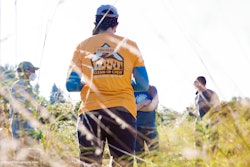
In recent years, corporate social responsibility (CSR) initiatives have become something of a non-negotiable for companies—particularly those who want to attract millennial and Gen Z employees and consumers. This past August, Entrepreneur magazine reported that 70% of investors want to spend money with companies that align with their values, and that the COVID-19 pandemic has brought CSR efforts to the forefront of people’s minds.
Companies and consumers alike are thinking more about diversity, equity, and inclusion, along with eco-friendly efforts and philanthropic causes. And it goes without saying that the same concepts apply to the event industry. More than ever, attendees want to support events that have a give-back component—like last week’s Florida Restaurant & Lodging Show, which donated all registration fees to support people impacted by Hurricane Ian.
And it goes well beyond just monetary donations. Hosting a CSR-focused activity on-site can also be a great way for event and meeting hosts to showcase their company’s values, create a fun team-building experience, and of course, encourage their employees and/or event guests to give back to the world around them.
We chatted with some experts to learn their top tips for hosting a give-back activity at an in-person event...
1. Find causes your attendees are excited about.
If you want to take your CSR activities beyond the superficial, it's important to focus on causes that your employees or attendees actually care about—and that may require some crowd-sourcing. Enlist the input of team members beyond just the executives or HR team, suggests Amanda Baudier, a Brooklyn-based executive coach for Full Plate Full Cup, who worked as an event planner for 14 years and has held CSR-focused roles for companies like Sakara Life and Melissa Wood Health.
"In order to get the team really excited to rally around a mission, it can't be a 'top-down' type of thing," she notes. "Have team members volunteer to help brainstorm and give feedback on initiatives rather than handing them an assignment—while, of course, being mindful of assigning unpaid labor."
Zephyr Chan, a Hong Kong-based growth marketer and the founder of the blog Better Marketer, agrees that the "cooperation, zeal, and commitment" of employees or attendees is crucial to ensuring success. "Input your team's values. Put this information to use once you've determined what matters most to your staff and where they want the organization to concentrate," he says. "Even though it's unlikely that you'll be able to take into account everyone's suggestions, at the very least, discuss your results with the group. Your staff will take pleasure in finding out what their other employees appreciate.”  Informa’s Greenbuild International Conference & Expo uses CSR programs to connect with local communities. For each expo, organizers select an annual “Legacy Project” that will continue to give back long after the conventioneers have left town. The council charges members $25 to submit a proposal for future Legacy Projects, a simple tactic that has become a vital fundraising source, raising as much as $13,000 each year. See more: Most Innovative Meetings 2016: #2 Greenbuild International Conference & ExpoPhoto: Ana Ka'ahanui
Informa’s Greenbuild International Conference & Expo uses CSR programs to connect with local communities. For each expo, organizers select an annual “Legacy Project” that will continue to give back long after the conventioneers have left town. The council charges members $25 to submit a proposal for future Legacy Projects, a simple tactic that has become a vital fundraising source, raising as much as $13,000 each year. See more: Most Innovative Meetings 2016: #2 Greenbuild International Conference & ExpoPhoto: Ana Ka'ahanui
2. Keep it local, and try to relate the giving back to the work that your company actually does.
With countless worthy causes to support, some of our experts advise making it personal. "I recommend focusing on local causes that will activate real passion among your staff," says Maria Britton, the CEO of Houston-based event company Trade Show Labs. "Cleaning up a park that many of your workers frequent or raising funds to install solar panels at a school that many employees send their kids to are two great examples in this vein.”
She continues, "Whether you're doing something radical like reducing your company's carbon footprint or something small and local like picking up litter, the more participants you have—and the more enthusiastic they are—the better your results are going to be, both for the earth and for your company's image."
Baudier also suggests tying the cause to your company's main mission. “For example, at [food delivery service] Sakara, our charitable partner was Wellness in the Schools. [The nonprofit] is on a mission to feed kids healthier food, and Sakara's mission is to feed adults healthier food," she says.  In August, skincare and makeup brand Shiseido teamed up with the World Surf League and the nonprofit Wildcoast for a beach cleanup, part of the ongoing Shiseido Blue Project initiative that launched in 2019. At this year’s event, actor Ian Somerhalder was on hand to both pick up trash and also explain the need for ocean wildlife and beach preservation.Photo: Jennifer Johnson Photography
In August, skincare and makeup brand Shiseido teamed up with the World Surf League and the nonprofit Wildcoast for a beach cleanup, part of the ongoing Shiseido Blue Project initiative that launched in 2019. At this year’s event, actor Ian Somerhalder was on hand to both pick up trash and also explain the need for ocean wildlife and beach preservation.Photo: Jennifer Johnson Photography
3. Lean into the team-building aspects—and consider implementing some healthy competition.
CSR can be a great way to bond a team, something that's been top of mind as employees return to offices and consumers return to in-person events. Lisa Jennings, the chief experience officer of Orlando-based team-building company Wildly Different, notes that CSR activities are by far the most popular type of event they host.
"[That was true] even before the pandemic, but interest has increased ever since, as people are eager to help others out and reconnect with one another in a fun way," she says. "The most popular type of events [we host] are those that help kids in need, [followed by] our canned food donation events such as 'Canned Goods Carnival,' where teams create carnival games out of donated food and then actually play all of the games their colleagues created." Another popular activity? "Our 'Race For Relief' program where teams build race cars out of items to be donated after the event and race them on a custom track, reminiscent of a soapbox derby!"
Kirsten McKinley, an event planner and the founder of the online magazine Weddings & Brides, adds that something as simple as litter-picking can be a fun and easy way to institute some friendly rivalry. "You can place the attendees into teams and make it into a competition, with a prize to up the motivation too," she suggests. "All you need are some guidelines and the right tools to pick litter with.”
4. Use real data to show the impact your company is having.
With so many causes to support, it can be easy to forget that small steps can have an impact. “There needs to be a quantifiable goal the company is working towards or a way to see the impact efforts are making," suggests Baudier as a way to keep teams motivated. "For example, at Sakara, we gifted everyone reusable coffee mugs. Every time someone went out to get a coffee and used one, we put a coffee mug sticker on a poster as a representation of a disposable cup that was not used. Employees could see the cups tally up as a way to measure the impact of an effort."  Last November, footwear and apparel brand Vans engaged more than 18,000 global fans for its annual Checkerboard Day, which aims to revitalize communities through worldwide activations and events. Activities included an initiative from Colectivo Tomate to transform a skatepark in Mexico City (pictured). See more: How Vans Engaged More Than 18,000 Fans for Its Global Charitable InitiativePhoto: Courtesy of Vans
Last November, footwear and apparel brand Vans engaged more than 18,000 global fans for its annual Checkerboard Day, which aims to revitalize communities through worldwide activations and events. Activities included an initiative from Colectivo Tomate to transform a skatepark in Mexico City (pictured). See more: How Vans Engaged More Than 18,000 Fans for Its Global Charitable InitiativePhoto: Courtesy of Vans
5. Bring your consumers and clients in on the mission, too.
While many of our experts have focused their tips on employees and internal meetings, Baudier notes that these initiatives should also be accessible to customers. “CSR is a non-negotiable for today's consumer brands," she advises. "When a company is able to engage both employees and customers in their mission in a way that feels authentic to what the company actually does, the whole story around CSR is more believable and drives more consumer and employee trust."
Baudier cites an example of an event she produced at Sakara—a virtual summit with Every Mother Counts that engaged Christy Turlington and other leaders in the women's rights space. While employees got free tickets, outside attendees were able to purchase tickets and all money was donated to the nonprofit. "Since Sakara is a brand with 90% female clientele, this event felt authentic and had experts with real data and talking points about the issue and the impact," she explains. "[It was] so much more powerful than simply just asking people to donate.”
6. Pay attention to the causes most impacting the world right now.
Hot topics right now include voting access, poverty, diversity and inclusion, and women's rights—with sustainability emerging as one of the most popular CSR causes, our experts say. For example, Sandra Rios, co-owner and director of client services at the Phoenix-based marketing firm Buzz Agency, likes to offer a fun twist on traditional sustainability-focused activities by highlighting the power of upcycling.
“With upcycling, you try to create something new out of something old, without reducing the original product to its component parts. By doing so, previously discarded objects are given a second chance," she says. "Everyone can benefit from the motivation, excitement, and originality of an upcycling workshop. It's even more enjoyable when everyone involved is working toward a common goal, such as making gifts to give to underprivileged kids or decorative items to give to elderly people in nursing homes."
She continues, "Participants can gain knowledge, aid in trash reduction, and become closer to one another all through one easy exercise.”  Alt Terrain recently worked with Santander Bank on an immersive cause marketing initiative called "In Someone Else's Shoes." The goal? To create awareness and empathy for people classified as "working homeless"—individuals with jobs, but living out of their vehicles or crashing at different houses each night. Folks were invited to install a pedometer app to track their steps. Santander Bank donated $10 for every mile people walked to Heading Home, a nonprofit organization in Boston. See more: 4 Expert Tips for Producing Impactful Cause Marketing ActivationsPhoto: Courtesy of Alt Terrain
Alt Terrain recently worked with Santander Bank on an immersive cause marketing initiative called "In Someone Else's Shoes." The goal? To create awareness and empathy for people classified as "working homeless"—individuals with jobs, but living out of their vehicles or crashing at different houses each night. Folks were invited to install a pedometer app to track their steps. Santander Bank donated $10 for every mile people walked to Heading Home, a nonprofit organization in Boston. See more: 4 Expert Tips for Producing Impactful Cause Marketing ActivationsPhoto: Courtesy of Alt Terrain
7. Keep the initiative going over multiple years.
Baudier advises companies to choose one cause or organization, and commit to it over a consistent period of time rather than jumping from cause to cause. "Over a longer period of time, customers and employees alike have a chance to really feel integrated and involved in the company mission. Soon, the company starts to be synonymous with the mission, which is great for building trust and loyalty to the business overall," she points out.
Consider an ongoing event series for a specific cause or charity partner, Baudier advises. "[This] drives maximum impact while reducing excessive planning—you create a framework and then replicate it over and over versus reinventing the wheel every time. Employees aren't stupid, so if CSR events feel wasteful and performative, they won't resonate.”
Above all, CSR activities don't need to be overly complex—they just need to feel authentic and impactful, sums up Baudier. "Employees want to feel like they and their company are making a real impact, rather than just checking a box so that they don't get 'canceled' or because they need something to market on Giving Tuesday.”



















